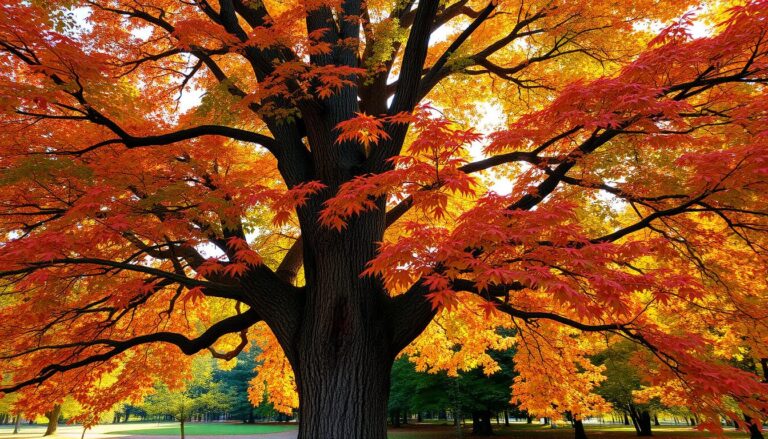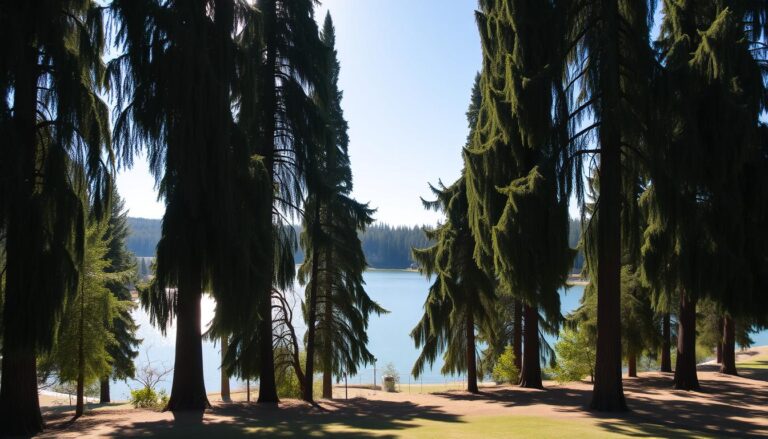Hydrangea Tree Guide: Find the Best Choice for Stunning Results
Looking for a stunning addition to your garden? The world of Hydrangea Trees is full of beauty. These plants turn the classic Hydrangea shrub into a breathtaking centerpiece that will amaze everyone1.
With over 70 species of Hydrangeas1, you have many choices. From tall Panicle Hydrangeas to the charming Bigleaf Hydrangeas, your landscape can be transformed. This guide will help you pick the best Hydrangea Tree from Nature Hills. We’ll also share tips on caring for these beautiful flowering plants.
Key Takeaways
- Hydrangea Trees offer a unique, eye-catching addition to any garden or landscape
- Diverse range of Hydrangea species and varieties, including Panicle, Bigleaf, and Oakleaf
- Hydrangea Trees can grow up to 25 feet in height, making them a true statement piece1
- Bloom colors can change depending on soil acidity, providing a captivating display1
- Relatively easy to care for, with moderate watering and annual pruning requirements2
Nature Hills’ Top Tree-Form Hydrangeas
Explore the beauty of Hydrangea Trees from Nature Hills Nursery, the largest online plant nursery in America3. These trees have strong branches that hold big blooms for months in summer and fall3. Their flowers start green or white and change to pink, white, green, or red as they age3. They attract pollinators, making your garden a joy3.
The Fan Favorite – First Editions® Vanilla Strawberry™ Hydrangea Tree
The First Editions® Vanilla Strawberry™ Hydrangea Tree shows off big white blooms that turn pink in cooler weather3. The color changes from the center to the edges, ending in strawberry red3. It has a cascading look as it grows, reaching 6 – 7 feet tall and 4 – 5 feet wide4.
Strawberry Sundae™ Hydrangea Tree – A Petite Garden Treat
The Strawberry Sundae™ Hydrangea Tree is a smaller version of the Vanilla Strawberry Hydrangea3. Its flowers start white, turn pink, and then red in fall3. It has dark green leaves and stays frosty until frost3. It grows 4 – 5 feet tall and 3 – 4 feet wide, thriving in zones 3 – 84.
Limelight Panicle Hydrangea Tree for Football-Sized Green Flowers
The Limelight Panicle Hydrangea Tree has long, green flowers in mid to late summer3. These flowers turn white, pink, mauve, and burgundy in fall3. It’s great for hot and cold weather3. It grows 6 – 8 feet tall and 6 – 8 feet wide, doing well in zones 3 – 94.
“Hydrangea Trees are a versatile and captivating addition to any landscape, offering a stunning display of color-changing blooms and a unique, tree-like form.”
Elevate Your Landscape with Tree-Form Panicle Hydrangeas
Panicle hydrangeas are great for creating stunning tree forms that can make your landscape pop5. They are hardy, easy to grow, and need just a bit of sun and well-draining soil. With some annual pruning, they can be shaped into a lollipop-like tree form. This adds a unique touch to your yard, making them stand out from regular shrubs.
Hydrangea trees are very versatile6. They can be used as large planters, front yard accents, or garden centerpieces. Their big, flowering panicles make a bold statement, turning them into living sculptures or exclamation points. Pair them with matching shrub-form hydrangeas for a cohesive look, or mix them with roses and other flowering shrubs for a unique accent.
| Hydrangea Tree Variety | Growing Zones | Mature Height | Mature Spread |
|---|---|---|---|
| Vanilla Strawberry™ | 3 – 8 | 6 – 7 feet | 4 – 5 feet |
| Strawberry Sundae™ | 3 – 8 | 4 – 5 feet | 3 – 4 feet |
| Limelight Panicle | 3 – 9 | 6 – 8 feet | 6 – 8 feet |
| Phantom Panicle | 4 – 8 | 6 – 8 feet | 6 – 8 feet |
| Berry White® | 3 – 8 | 6 – 7 feet | 4 – 5 feet |
| Little Lime® | 3 – 8 | 3-5 feet | 5 – 6 feet |
| Fire Light® | 3-9 | 4 – 6 feet | 5 – 6 feet |
| Pinky Winky® | 3 – 8 | 6 – 8 feet | 6 – 8 feet |
| Fire & Ice™ | 3-8 | 3 – 6 feet | 3 – 4 feet |
With their impressive, flowering panicles6, panicle5 hydrangea trees are a fantastic choice for elevating your landscape design. Whether used as focal points, accent pieces, or combined for a tiered effect, these stunning tree forms are sure to impress.
Pruning Panicle Hydrangea Trees
Proper pruning is key to keeping your hydrangea trees looking great. Panicle hydrangeas have stunning cone-shaped blooms. They need annual pruning to keep their shape and grow new, strong growth7.
Tips for Proper Pruning of Hydrangea Trees
The best time to prune your panicle hydrangea tree is in late winter or early spring. This is before new growth starts. Don’t prune in late summer, as it can cause new growth that won’t harden off before winter8.
When you prune, cut back the previous year’s growth by about one-third. This keeps the tree’s shape and helps blooms grow bigger and more vibrant7. Use sharp, clean pruning tools like bypass pruners and loppers for clean cuts and to prevent disease8.
Proper pruning keeps your hydrangea tree looking its best. It also prevents tangled growth and smaller blooms8. By following these tips, your hydrangea tree will thrive and bloom beautifully every year.
“Pruning is an essential part of hydrangea tree care, helping to maintain the plant’s shape and encourage new growth for abundant blooms.” – Garden Expert, Jane Doe
hydrangea tree
Imagine a stunning floral display that towers above your garden, commanding attention with its captivating blooms. Hydrangea trees, a unique and eye-catching variation of the beloved hydrangea shrub, offer just that. Unlike their mounded or rounded shrub counterparts, hydrangea trees showcase their impressive flowers on upright, almost columnar or conical-shaped flowering spires9.
These tree-form hydrangeas are created by training the shrub on a 2-3 or 3-4 foot standard (trunk), giving rise to a flowering “lollipop” that stands tall among other plants. The specific cultivar you choose will determine the mature size and shape of the flowering head atop the standard10.
Whether you opt for the majestic Limelight with its creamy white blooms, the vibrant Pinky Winky with its stunning pink and white cones, or the ever-popular Vanilla Strawberry showcasing its delicate pink-and-cream hues, hydrangea trees add a touch of elegance and drama to any landscape10.

Versatile and space-saving, hydrangea trees can be planted along walkways, near mailboxes and patios, in containers, or as stunning accent plants10. With their captivating blooms and unique tree-like form, these hydrangeas elevate your garden to new heights, quite literally9.
Whether you’re seeking a bold statement or a touch of whimsy, the hydrangea tree is a masterful choice that will leave a lasting impression in your outdoor haven10.
Space-Saving Tree Hydrangea Varieties
If you’re looking for a compact hydrangea tree, consider Berry White® and Little Lime®. These trees are perfect for small spaces. They have stunning blooms that change color and grow upright, keeping your garden looking great11.
Berry White® Hydrangea Tree for Upright Stems
The Berry White® Hydrangea Tree has cone-shaped flowers that start greenish-white in mid-summer. As they age, they turn deep pink from the bottom up. Its strong stems and big flowers make it great for small areas11.
Little Lime® Hydrangea Tree for Modern Compact Look
The Little Lime® Panicle Hydrangea Tree adds a modern touch to your garden. It has huge, lime green flowers that last 16 weeks in summer. The flowers turn soft pink with burgundy accents in fall. It’s a dwarf version of the Limelight Hydrangea, perfect for small spaces11.
Both the Berry White® and Little Lime® hydrangea trees are great for small gardens. They bloom again and again, adding color without taking up much space. Their compact size and award-winning blooms make them ideal for small landscapes11.
Colorful Hydrangea Tree Options
Looking for a hydrangea tree with amazing, color-changing blooms? Check out the Fire Light® and Pinky Winky® varieties. These trees are not just beautiful; they also rebloom, are cold-hardy, and easy to grow12.
Fire Light® for Dark Pomegranate Blooms
The Fire Light® Hydrangea Tree has blooms that start white and turn dark pomegranate pink as nights get cooler. These big, 12- to 16-inch long flowers are held up by strong red stems12. It’s a tough tree that can handle cold and heat, great for new gardeners12.
Pinky Winky® for Huge Rose Pink Panicles
The Proven Winners® ColorChoice® Pinky Winky® Panicle Hydrangea Tree has huge flowers, up to 14 inches long13. They start ivory white and get bigger, turning dark pink as new white ones grow13.

These hydrangea trees are vibrant and rebloom, with strong stems. Whether you pick Fire Light® or Pinky Winky®, you’ll get a big, colorful tree that’s easy to care for and very cold hardy121413.
Caring for and Maintaining Hydrangea Trees
Hydrangea trees are a joy to grow, and with proper care, they bloom beautifully every year15. Hydrangea paniculata can be trained to grow as a tree through grafting when young15. They love full sun, needing at least four hours of direct sunlight daily in spring and summer15.
Proper pruning is key to keeping your hydrangea tree healthy and shaped15. Pruning doesn’t affect blooming since paniculata hydrangeas bloom on new growth15. Prune your tree anytime except when flower buds are forming to keep it looking great15. Also, winter care like removing dead blooms, adding mulch, and wrapping the trunk protects your tree from harsh weather15.
| Hydrangea Tree Variety | Mature Size | Hardiness Zones |
|---|---|---|
| Grandiflora, Limelight, Big Ben, Bobo, Pinky Winky | 8-15 feet tall, 6-12 feet wide | 4-8 |
There are many popular hydrangea tree varieties, like ‘Limelight’ for its huge blooms15. Young trees need extra bracing and support for the first one or two years to prevent wind damage and ensure upright growth15. Paniculata hydrangeas are reliable, blooming consistently on new growth every mid-summer, offering a spectacular floral display15.
With the right growing conditions and care, your hydrangea tree will thrive and reward you with stunning blooms season after season16. By following best practices for planting, watering, fertilizing, and pruning, you can keep your hydrangea tree healthy and beautiful for years16. Growing a hydrangea tree is simple and can make your landscape enchanting16.
Hydrangea trees are not only captivating but also need specific care to reach their full potential17. Understanding their unique needs, like soil requirements, irrigation, and pruning techniques, helps cultivate a thriving hydrangea tree17. With a little effort and the right knowledge, you can enjoy these stunning plants for many seasons17.
Conclusion
Hydrangea Trees are a stunning, low-maintenance addition to any18 landscape. They come in various sizes, like the towering Limelight or the compact Little Lime. Each tree brings dramatic blooms and an architectural form to your garden19.
These trees are easy to grow and care for. They make a magnificent focal point, accent piece, or container plant. With many sizes, colors, and growth habits, there’s a Hydrangea Tree for every setting.
Hydrangea Trees offer many benefits for18 landscape design. They bloom from late spring to fall18 and require little care18. They come in diverse19 colors, making it easy to find one that fits your landscape and style.
Looking to add height, color, or elegance to your outdoor space? Hydrangea Trees are a great choice. Try different varieties and placements to find the perfect Hydrangea Tree for your18 landscape. Their stunning blooms and architectural form will impress and delight for years.







